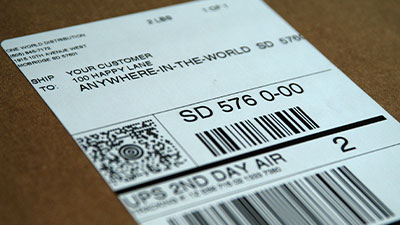In This Article:
High shipping rates are a major obstacle to the profitability of any ecommerce business. These costs can quickly eat into profits, making it crucial for businesses to find ways to secure discounted shipping rates.
The average shopping cart abandonment rate is around 70%. Shipping fees and other extra costs are the main reason why shoppers decide to leave, so finding ways to offer discounted rates is essential to boost conversions.
Although almost 74% of shoppers say they want free shipping, 35% prefer discounts over free shipping. Big retailers like Amazon have set the standard with two-day free shipping for Prime-eligible products, so you need to find a way to offer comparable service without excessive fees that drain your profits.
74%
of shoppers say they want free shipping.
Working with the right third-party logistics provider (3PL) is essential. Not only can it help you achieve cheaper rates, but it can also improve your fulfillment efficiency—a double benefit that supports sustained business growth.
Our expert logistics team has over 30 years of experience in securing discounted shipping rates for ecommerce businesses like yours. Partnering with us gives you access to decades of industry expertise and trust. The following insights will help you navigate through shipping complexities, ensuring cost-effective solutions tailored for your specific needs.
Why Are Shipping Costs So High?
Understanding the reasons for high shipping costs is essential for any ecommerce business. Several factors contribute to these elevated expenses:
- Fuel Prices: Fluctuations in fuel prices directly impact shipping rates. As fuel costs rise, carriers pass these expenses onto businesses, increasing overall shipping fees.
- Demand Fluctuations: Peak shopping seasons often lead to a spike in demand, resulting in higher shipping costs due to increased competition for carrier services.
- Logistics Challenges: The complexities of logistics, including supply chain disruptions and inefficient routing, can drive up operational costs. These inefficiencies are reflected in the final shipping charges.
- Carrier Pricing Strategies: Carriers employ sophisticated pricing strategies that are influenced by market competition. Small businesses often find themselves disadvantaged as they lack the bargaining power of larger enterprises.
Navigating these hurdles and managing shipping expenses quickly becomes a challenge, especially for small and medium-sized businesses aiming to retain profitability while staying competitive. Reducing logistics expenses while still facilitating fast, on-time deliveries is an expensive hurdle that is hard to tackle if you’re doing it alone.
How Much Does Shipping Cost?
Average shipping costs can vary significantly across carriers such as USPS, UPS, and FedEx. For instance, shipping a standard 5-pound package domestically could range from $10 to $85, depending on the service level and carrier selected.
Several factors influence these shipping prices:
- Size and Weight: Larger or heavier packages naturally incur higher fees due to increased handling and transportation requirements.
- Distance: Shipping rates escalate with distances covered, with international shipments often seeing substantial surcharges.
- Service Level: Choosing expedited services like overnight delivery will result in higher costs compared to ground shipping options.
For businesses looking to save money on shipping, it’s vital to conduct a comprehensive shipping price analysis. By examining these cost determinants, you can identify areas where adjustments can be made, such as optimizing packaging size or selecting alternate routes. Accessing shipping discounts through volume agreements with carriers also presents an opportunity to reduce shipping expenses substantially.
Efficient cost management in this area not only enhances profitability but also improves customer satisfaction by allowing you to offer competitive pricing and faster delivery times.
6 Ways to Secure Discounted Shipping Rates
1. Negotiate with Carriers
Unlocking discounted shipping rates begins with strategic carrier negotiations. Engaging with major carriers such as USPS, UPS, and FedEx requires a tactical approach. Start by understanding the unique needs of your ecommerce business and aligning them with what each carrier can offer.
- Research Carrier Options: Different carriers provide varying services and pricing structures. Depending on the scale and frequency of your orders, getting a transparent quote on what you'll expect to pay is essential.
- Initiate Negotiations: Contact carrier representatives to discuss potential discounts. Highlight your shipping volume as leverage—the greater your shipping volume, the more negotiating power you possess.
- Demonstrate Shipping Volume: Providing detailed data on your monthly or annual shipping volumes can significantly strengthen your negotiation position. High-volume shippers often qualify for substantial rate reductions.
- Explore Long-Term Contracts: Consider committing to long-term agreements with carriers willing to offer favorable terms in exchange for guaranteed business. This could lead to lower costs per shipment.
- Leverage Industry Connections: Utilize industry networks or trade associations that might offer collective bargaining options for smaller businesses, thus accessing discounts usually reserved for large enterprises.
Engaging in these negotiations secures cheaper rates for your ecommerce business and establishes a mutually beneficial relationship with carriers. Discounted shipping rates are crucial for maintaining competitiveness and profitability so you can compete with big retailers.
2. Implement Shipping Zones and Distributed Inventory Strategies
 Positioning your inventory strategically across multiple fulfillment centers can lower shipping distances, resulting in cheaper rates for your ecommerce business. By implementing distributed inventory, you cut down on transit times, which not only reduces shipping costs but also enhances customer satisfaction due to faster deliveries. OWD helps facilitate two-day delivery with ground shipping across the country with three fulfillment centers located in California, South Dakota, and Ohio for 99% of domestic shoppers.
Positioning your inventory strategically across multiple fulfillment centers can lower shipping distances, resulting in cheaper rates for your ecommerce business. By implementing distributed inventory, you cut down on transit times, which not only reduces shipping costs but also enhances customer satisfaction due to faster deliveries. OWD helps facilitate two-day delivery with ground shipping across the country with three fulfillment centers located in California, South Dakota, and Ohio for 99% of domestic shoppers.
Establishing shipping zones is another effective strategy that can help secure discounted shipping rates. Shipping zones are determined based on the distance between the point of origin and the destination. By keeping inventory closer to customers within specific zones, you optimize delivery routes, minimizing both time and cost.
Here are two key strategies to consider:
- Inventory Distribution: Distribute products across regional fulfillment centers to reduce the average distance packages travel.
- Strategic Shipping Zones: Create zones that align with high-demand areas to ensure quick and cost-effective deliveries.
Engaging with carriers and discussing these strategies can lead to more favorable freight agreements. Establishing shipping zones and implementing inventory distribution will help you secure cheaper rates and improve overall operational efficiency.
3. Use Shipping & Fulfillment Software Solutions
Using shipping software solutions is crucial for eCommerce businesses looking to get discounted shipping rates. Platforms like Shippo allow you to compare rates from different carriers in real time, making it easy to choose the most affordable option quickly. This feature simplifies carrier negotiations and improves freight agreements.
Rate Comparison Tools
Tools like Shippo gather shipping rates from carriers such as FedEx, UPS, and USPS, providing a comprehensive view of available pricing options. By using these tools, you can ensure that each shipment is sent at the most competitive rate.
Automation Benefits
Automating your shipping process not only reduces manual errors but also improves efficiency by streamlining operations. This includes generating labels, tracking shipments, and managing returns seamlessly, resulting in significant cost savings.
4. Consider Flat Rate Shipping Options for Small Businesses
Navigating the complexities of carrier negotiations and freight agreements can be daunting, especially when aiming to secure cheaper rates for your ecommerce business. One effective strategy to achieve discounted shipping rates is leveraging flat-rate options.
USPS flat rate boxes provide a straightforward solution for small businesses seeking predictable shipping costs. These boxes come in standard sizes with predetermined prices, allowing you to ship anywhere domestically without worrying about weight fluctuations. This eliminates the typical cost variables and simplifies budgeting.
The question remains: is flat rate shipping cheaper? While it often offers competitive pricing, it’s crucial to analyze your specific shipping needs:
- Volume and Frequency: If you're frequently shipping items that fit USPS flat rate boxes, this method can yield significant savings.
- Weight Consistency: For heavier items that fall within the weight limits of flat-rate offerings, this option often proves economical.
- Distance Considerations: Flat-rate boxes shine when sending packages across long distances, where traditional weight-based pricing would surge.
Flat rate options provide a reliable avenue to secure discounted shipping rates for your ecommerce business. Understanding your shipping profile and aligning it with these standardized solutions can result in substantial savings.
5. Lower Shipping Costs by Weight or Box Size Optimization Strategies
Optimizing packaging is a crucial strategy for securing discounted shipping rates. The size and weight of your packages directly impact the costs, making it essential to determine whether it’s cheaper to ship by weight or box size. Carriers often have specific policies regarding dimensional weight pricing (DIM), where the size of the package can outweigh its actual scale weight, leading to higher fees.
Key Strategies:
- Package Design: Streamline your packaging design by selecting materials that provide adequate protection without excessive bulk. This not only reduces DIM charges but also enhances sustainability efforts.
- Carrier Policies: Understand carrier-specific pricing structures. Some carriers prioritize weight over size, while others may impose higher costs based on dimensions. Engaging in carrier negotiations and understanding these nuances can lead to freight agreements that favor your shipping profile.
- Weight vs Box Size Analysis: Conduct a thorough analysis comparing shipping costs for varying weights and sizes under different carrier policies. Consider investing in technology that automates this process, such as packaging optimization software or dimensioning systems, to streamline operations and ensure accuracy in your calculations.
6. Bonus Tactics: Explore Other Relevant Strategies for Securing Discounted Rates
While most retailers struggle with crushing shipping expenses, industry insiders quietly use these four tactics to slash costs. Each strategy requires minimal effort but delivers immediate savings to your bottom line:
Unlock "Members-Only" Commercial Pricing
The major carriers maintain two separate rate sheets: the inflated prices they quote to small businesses and the dramatically reduced rates they offer to volume shippers. The secret? You don’t need Amazon’s volume to qualify. By strategically consolidating your shipments to meet surprisingly accessible thresholds, you can instantly access these privileged rates.
Exploring 3PL Partnerships
Why negotiate from a position of weakness when you can leverage someone else’s buying power? Third-party logistics providers like One World Direct have already secured the preferential rates you’re fighting for. Their established freight agreements can immediately cut your costs by 20-40%, while simultaneously improving delivery times. This isn’t just outsourcing – it’s accessing a shipping rate ecosystem that’s otherwise closed to all but the largest retailers.
Turn Carrier Relationships into Tangible Savings
The traditional retailer-carrier relationship leaves money on the table. Forward-thinking businesses are implementing structured loyalty programs with their carriers, creating mutually beneficial arrangements that generate escalating discounts over time. These aren’t just modest savings – they often include priority handling during peak periods when your competitors’ packages sit idle.
Deploy the Freight Forwarder Secret Weapon
The difference between standard and insider rates for international shipping can be pretty excessive. Freight forwarders consolidate shipments from multiple businesses, giving your packages access to volume discounts you could never qualify for alone. Beyond savings, they optimize routing to reduce both costs and delivery times.
Consistent Discounted Rates and Much More
Your competitors could be securing shipping rates 30-40% lower than yours right now. How? By working with logistics partners who’ve already won the negotiation battle.
Book Your Free Shipping Rate Analysis Today and discover precisely how much you’re overpaying – down to the penny.
What You'll Get When You Act Today:
- Immediate Savings Assessment: Our team will analyze your current shipping spend and show you precisely where we can cut costs without sacrificing delivery times.
- Coast-to-Coast 2-Day Strategy: Leverage our three strategically-positioned fulfillment centers to reach 99% of domestic customers in just 2 days with ground shipping.
- Profit Center Transformation: Convert your fulfillment from a cost center to a revenue generator with our P2C (Personalized-to-Consumer) services. Start offering product personalization and boost average order values and brand equity. Visitors can use the free plugin to personalize items with custom engravings, embroidery, and direct-to-object printing, with options for custom packaging and personalized greeting cards.
- Industry-Leading Ecommerce Customer Service: For more than 20 years, we’ve helped our clients deliver exceptional customer service through our call center services. Our American agents handle calls, emails, and chats following your strict brand guidelines.
The Cost of Waiting Just 30 Days:
For an ecommerce business shipping 50 packages daily, each week of delay costs approximately $1,750 in unnecessary shipping expenses. Act now and start saving on fulfillment with OWD!
In This Article:
Subscribe to our Newsletter
Tincidunt urna mauris eu quam vulputate lobortis sit. Purus feugiat arcu nunc quisque massa ut.



























